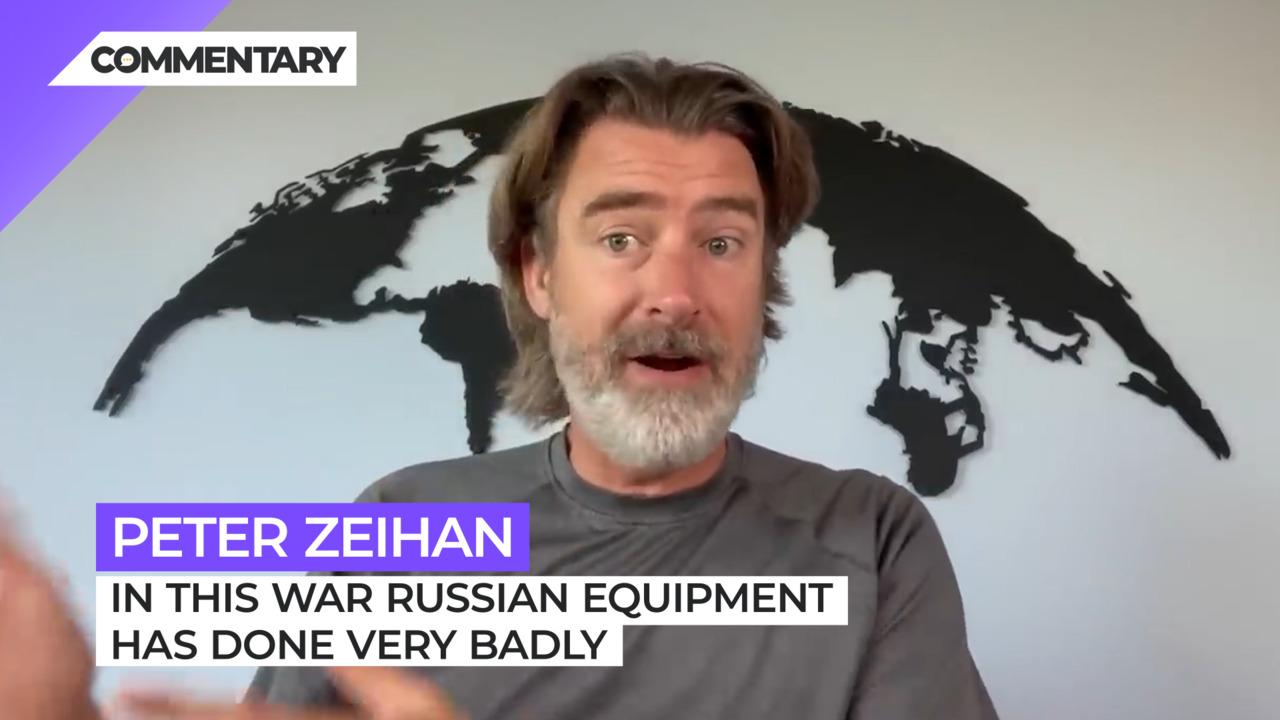
Commentary
-
Our commentary partners will help you reach your own conclusions on complex topics.
Hey, everybody, Peter Zane here coming to you from Colorado. Today I wanted to talk about a little bit of the mechanics of the Ukraine war, specifically some of the weapon systems that are in play. Now we’ve all seen the stories about the Ukrainians and the Russians using drones to identify and target assets on the other side. But the new news is that the Russians are having so much of a problem with their own drones and so much difficulty replacing the ones they’ve lost. They have turned to an most unexpected source from materials not going under the international market traditional sense not going to the Chinese go into the Iranians who are not exactly what I would consider a modern industrial power. Specifically, the Russians have purchased what looks to be a few dozen of the the effect of these pronunciations, right, Mohammed air model and the showerhead model. Both of them are capable of carrying multiple 40 to 80 pound ground excuse me air to ground munitions. The Moza air has started mohajir has a range of about 120 miles. In theory, the showerhead can go significantly further, perhaps more than 1000. But both of them require ground control capability. And since the Iranians don’t have a single satellite, we really don’t know what their maximum range might actually be, because they’ve never demonstrated anything. So we’re relatively short range capability. More importantly, both of these new drones are new to the Russians require runways for takeoff and landing. So they can’t be used in advanced position, they’re more to be used as kind of a replacement for fighter bombers, in places where you know, there’s going to be a target rich environment, which is not the sort of environment the Russians have really been dealing with. And certainly not the kind that the Koreans have been dealing with, because then they would need the runways. Anyway, some folks are a little bit nervous about anything that puts Iran and Russia into the same sentence. But I’m really not. Iran is not an industrial power. They have manufactured less than 300 of these things for their own. And even if all 300 were suddenly to be thrown into the Ukraine war, the restrictions on where they can operate. And what they can do means that they’re probably not going to be having a big impact on any particular Battlefield, even if they work well. And some of the reports that we’ve gotten out so far suggest that they’re absolutely not working all that well. If anything, I see this as an extremely enlightening sign of just how much trouble the Russians are in with their industrial and technical collapses. It’s clear from the sort of equipment that the Russians are bringing in that they can’t replace anything at scale. And so they’re dusting off tanks that were built in the 60s and haven’t been modernized since the late 70s to be their new mainline tanks. And if they can’t put just a few dozen drones into the field into production, in a reasonable timeframe, to the point that they’re actually importing finished equipment from third countries that are not leading lights when it comes to manufactured goods, you got to wonder what the maintenance is like for everything else that they have. So for example, think artillery. This is how the Russians have been fighting the war to this point, they’re using over 40,000 shells a day. And most barrels once they fire one to 2000 shells, that’s it, they’re done. You have to take them out of commission and replace them. And with some of the older equipment that the Russians are using, they can never even get to that 1000 You have 600 might be as far as you can go.
So we’re seeing equipment failures in a lot of places. And that’s probably probably probably why the Eastern assault of the Russians on Luhansk stalled out. I’m sorry, Donetsk stalled out about a month ago. Even worse, far worse for the Russians is until this war happened. Russia was the world’s number two arms exporter by value. In fact, they’ve been relying upon the income from those weapons sales to keep their industry alive. There hasn’t been enough demand from the Russian military itself to justify its existence. And in this war, Russian equipment has done very badly. So every country in the world that has imported a lot of Russian equipment to rent out their forces or to mainline their forces, they’re now having second, third and fourth and fifth thoughts about whether or not this is something they want to do it all. In particular, we should be watching the Indians because they India is the only country that has actually provided the seed and development capital that’s necessary to develop some of the more advanced weapon systems, whether it’s jets or helicopters or cruise missiles, and they’re in the process of backing away from almost all of it. And that is their number one the Russians number one market right there. About the only thing about this weapon sales from Iran to Russia that I see that I’m a little bit concerned about is that ground connection thing now Arabians have to have basically a line of sight so as to be a ground station that can communicate with the drone in the United States. We use satellites Koreans don’t have a satellite, but the Russians do. So the Iranians here are probably going to get a lot of great technical data on what it means when you can integrate one of their hardware systems with someone else’s communications network, and down the road that is likely to provide a bit of a boost to the Iranian weapons industry. That’s not a problem for today. That’s a problem for later. But if you’re going to worry about some aspect of that, that’s probably what you’d be concerned about. Okay, that’s it for me. Until next time, everyone quick addendum, we were just about to load up the report on Iran, drone, renting and drones going to Russia. Everything on that stands. But the new news just now is that the Russians are also getting artillery supplies from North Korea of all places. Now, everything we said about the Iranian drone program and what it means for Russia and the war effort that stands However, Russia is the world’s single largest artillery force, and it has the world’s largest artillery manufacturing capacity, and it has the world’s largest artillery shell stockpiles. But by far, by far, just huge amounts compared everyone else. If this is true, and they really are now, turning to the North Koreans for equipment, two things come out of this, it means that the Russian military industrial complex is already in a state of collapse. If the one thing that we know they’re good at, they can’t even maintain flow rates, then this is the end of the Russian military capacity over the next few years. And that is obviously something with significant impacts of luck, wait and see. A second. We haven’t gotten a good look at the inside of the North Korean military complex since 1953. The last time they were involved in general hostilities. So if we’re about to see millions of North Korean artillery shells being used by the Russians, we’re finally going to get a good look at what the North Koreans are capable and whether it’s good, bad or indifferent. That is more information than we have had in over a half a century and that’s going to be fantastic from an intelligence point of view. Okay, that’s it. For real. Take care.
-
How could RFK Jr. impact 2024 election?
Many Americans speculated about how a potential RFK, Jr. campaign might impact the 2024 elections. While RFK is neither a Democrat nor a Republican, many of his positions favor Donald Trump’s base over Joe Biden’s, particularly his various conspiracy theories on a wide range of subjects. Straight Arrow News contributor Peter Zeihan says that GOP…
-
Global warming won’t impact Russian-Chinese shipping
The seas above Russia’s northern coastline are too frozen for shipping, but some have wondered whether global warming might change that in the decades to come. If those seas were to become navigable for commercial shipping, new direct routes between Russia and China could theoretically open up. Straight Arrow News contributor Peter Zeihan throws more…
-
Can other nations replicate success of US shale revolution?
The “shale revolution” has provided the United States with a bountiful domestic supply of oil. But extracting oil from shale is a highly technical process, and it is also dependent on specific geological formations. Straight Arrow News contributor Peter Zeihan tackles the question of whether or not other nations might be able to replicate the…
-
Peace between Israel and Iran, at least for now
A series of recent airstrikes between Israel and Iran inflamed fears of a wider regional war erupting in the Middle East. That concern now seems to have paid off, after third-party countries around the world successfully intervened and talked down military hardliners in both Israel and Iran in order to avoid such an outcome. Israel’s…
-
Global internet in a precarious state, but that could be a positive
Over 500 underwater cables span over 870,000 miles worldwide, serving as the foundation of the modern global internet. Despite their critical role in facilitating communication, these cables often go unnoticed, even as the amount of data transmitted through them has surged. So what happens if the cables fail? Straight Arrow News contributor Peter Zeihan contends…
Latest Stories
-
 Getty Images
Getty Images
Biden uses NFL draft ad to try to connect with young voters
-
 Getty Images
Getty Images
Powering pot: Energy for US cannabis industry could electrify 13.5M homes
-
 Getty Images
Getty Images
Allies plan for Trump to have more control over interest rates
-
 Getty Images
Getty Images
FDA: Bird flu found in 1/5 commercial milk samples, suggests greater spread
-
 Reuters
Reuters
China permanently deploys warships to second overseas base
Popular Opinions
-
In addition to the facts, we believe it’s vital to hear perspectives from all sides of the political spectrum.
Latest Opinions
In addition to the facts, we believe it’s vital to hear perspectives from all sides of the political spectrum. We hope these different voices will help you reach your own conclusions.
The opinions published in this section are solely those of the contributors and do not reflect the views of Straight Arrow News.

















Latest Commentary
We know it is important to hear from a diverse range of observers on the complex topics we face and believe our commentary partners will help you reach your own conclusions.
The commentaries published in this section are solely those of the contributors and do not reflect the views of Straight Arrow News.
Peter Zeihan
Geopolitical StrategistGlobal warming won’t impact Russian-Chinese shipping
Can other nations replicate success of US shale revolution?
Peace between Israel and Iran, at least for now
Dr. Frank Luntz
Pollster and Political Analyst‘Take the job seriously’: Why Americans are fed up with Congress
‘If we can shrink it, it will stop growing’: Americans talk debt, deficit
‘I don’t think they care’: Undecided voters explain their reasons
Pete Ricketts
U.S. Senator for Nebraska